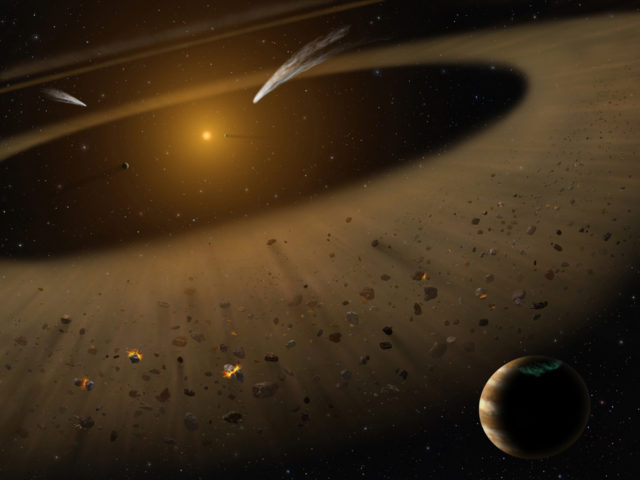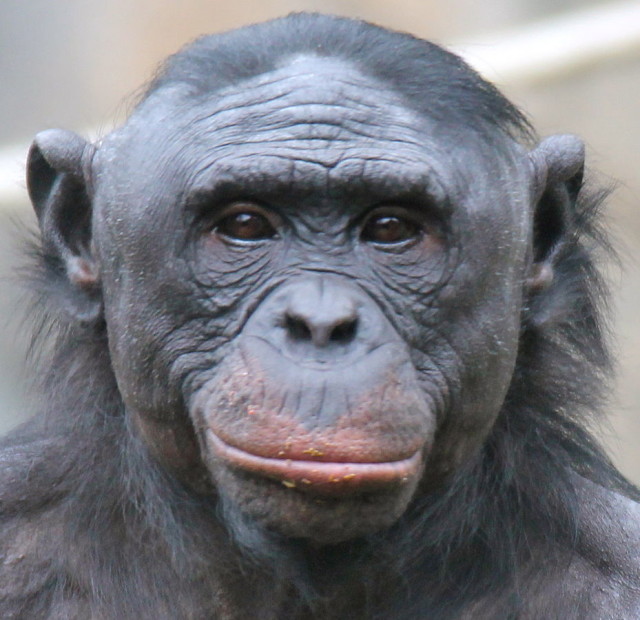
An artist’s illustration of the epsilon Eridani system showing Epsilon Eridani b, right foreground, a Jupiter-mass planet orbiting its parent star at the outside edge of an asteroid belt. In the background can be seen another narrow asteroid or comet belt plus an outermost belt similar in size to our solar system’s Kuiper Belt. (NASA/SOFIA/Lynette Cook)
Nearby Planetary System Mimics our Solar System
A group of scientists using NASA’s airborne Stratospheric Observatory for Infrared Astronomy or SOFIA recently completed a study that confirmed their previous findings of a young and nearby planetary system.
The researchers found that the system surrounding the star Epsilon Eridani, which is about 10.5 light years away from our sun but is 3/5 its age, has an architecture that resembles our own solar system.
Our solar system has the asteroid belt and the Kuiper belt, two circumstellar disks filled with various debris such as asteroids, comets, and other objects.
The research team found and then confirmed that the Epsilon Eridani system also has two debris disks circling in similar positions and distances as those in our own planetary system.
The researchers also found evidence that a planet with about the same mass as Jupiter circles its star at a distance similar to our giant planet to the Sun.
Bonobo May Be Human’s Closest Living Relative
A new study suggests that we modern humans may be more closely related anatomically to a species of great apes called the bonobo than the chimpanzee.
Researchers from Howard University and George Washington University, two Washington, DC universities made their findings after examining and comparing the muscular systems of the three species.
Past research including a gene sequencing conducted back in 2012 found that both chimpanzees and bonobos share 99% of our DNA.
Bernard Wood, from George Washington University, is one of the three authors of the study.
He says that bonobos are the closest we can get to a living ancestor since the team’s research found bonobo muscles have changed the least.
Scientists think that modern human split from the common chimpanzee/bonobo lineage about 8 million years ago with the two great ape species splitting about 2 million years ago.

This artist’s rendering shows NASA’s Cassini spacecraft above Saturn’s northern hemisphere, heading toward its first dive between Saturn and its rings on April 26, 2017.
(NASA/JPL-Caltech)
The Big Empty Between Saturn and Its Rings
Scientists at NASA’s Jet Propulsion Laboratory are calling the roughly 2,000-kilometer-wide gap between Saturn and its innermost set of rings “the big empty” after the space agency’s Cassini spacecraft found the region to be relatively free of dust particles.
NASA says data gathered by the space probe during its recent inaugural “dive” through this gap has pleased its engineers while perplexing scientists who study the rings of Saturn.
Expecting the area to be filled with dust particles, the Cassini team had to configure the spacecraft for the dive so that its saucer-shaped main antenna could be used to protect its delicate observational instruments.
Finding it relatively dust free will allow NASA to more freely use Cassini’s observational instruments for the remaining planned dives through the gap.
A part of the Cassini Mission’s “Grand Finale”, the series of plunges through this area is scheduled to run once a week before the spacecraft is sent crashing into Saturn on September 15, 2017.
Heart Trouble Risk for Those with Non-Type-O Blood
Here’s some troubling news for people who have anything but type O blood.
According to a new study, if your blood type happens to be either type A, B or AB, you’re at a higher risk of heart attack.
The study’s findings are based on an analysis of reports of cardiovascular events such as myocardial infarction or heart attack, coronary artery disease, ischemic heart disease and heart failure.
The reports were divided into two groups; those with Type-O blood and those with other blood group types.
The study found that odds of non-O-blood type carriers, experiencing all types of coronary events were significantly higher than the group with type O blood.
But the analysis also reveals that when it came to fatal coronary events, there was no significant difference between people with type O and non-O blood groups.
What Would Kill More People in an Asteroid Strike?
NASA’s Near-Earth Object Observations Program says that there is a less than .01 percent chance of a potentially hazardous asteroid hitting our planet within the next 100 years.
A new British study examines how lives would be lost due to any of the effects related to asteroid impacts.
Using computer simulations of varying sized asteroid impacts, the study suggests that 60 percent of all lives lost would be due to wind blasts and shockwaves.
The researchers explain that violent shock waves, which can cause internal organs to burst, are created by a sharp increase atmospheric pressure following an impact.
The powerful wind blasts would be strong enough to fling human bodies and crush forests.
The study finds only asteroids at least 18 meters wide were lethal.
Fortunately, most of the asteroids that reach Earth burn up in the atmosphere before impact.



























Comments are closed.